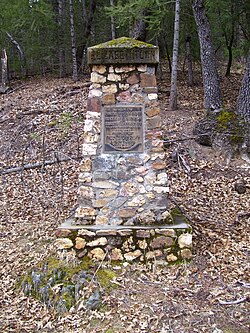Elizabethtown, CA
| Elizabethtown | |
|---|---|
| Former settlement | |

California Historical Landmark marker at the site of the former town
|
|
| Coordinates: 39°57′50″N 120°57′25″W / 39.963839°N 120.957081°WCoordinates: 39°57′50″N 120°57′25″W / 39.963839°N 120.957081°W | |
| Country | United States |
| State | California |
| County | Plumas County |
| Reference no. | 231 |
Elizabethtown, California was a California Gold Rush town that began in 1852 in Plumas County, California. It was named after a woman in the miners camp called Elizabeth Stark Blakesley.
It is said that the value of gold taken from the Elizabethtown area ran into the millions of dollars. It was started from other gold mining camps all around American Valley (where Quincy, CA is now located). In 1852, a 10 to 15 family wagon train came up Beckwourth Pass (which was created by James Beckwourth, the first pioneer to this area). They brought a large supply of horses, oxen, cows, and other needed supplies and were the first settlers of American Valley. When they got there, they found a population of hundreds of Maidu Indians, which were peaceful and friendly.
In 1852 Alexander and Frank Tate discovered gold in what is known as Tate ravine. After that, Lewis Stark, Peter Day, and George Ferrier one morning went up Elizabeth ravine and by noon they panned out an ounce of gold. After dinner they found several ounces using a rocker. After digging a small ditch, they discovered one 28 ounce gold piece. After that many miners came to search for gold which developed into a village. Later on Elizabethtown was also known as Betysburg after a rivalry started with Quincy. The winter of 1852 and 1853 were very harsh with low provisions. So the spring of 1853 the Stark family went to Sacramento Valley and hauled up many cattle for beef for the starving families.
In 1854 a Masonic Lodge was built there. Also in 1854 Elizabethtown got postal service with Lewis Stark as Postmaster. W.A. Blakesley was the Deputy and used his house as the office. In January 1855 the postal service was moved to Quincy. The rich mining claims of 1853 and 1854 were: The Wahoo, by Joseph Kelley & Co.; Fowler, by Fowler & Co.; Varner, by Varner & Co.; Plumas, by L.F. Cate & Co.; O'Neill, by Captain O'Neill; Gloyd, by D.J. Gloyd; and Betsy Guilch, by Stark & Co.
...
Wikipedia
